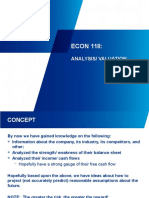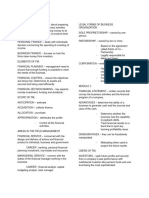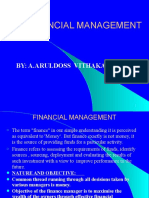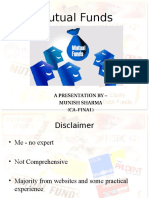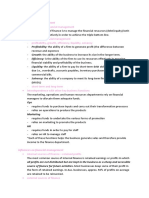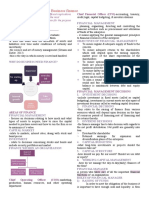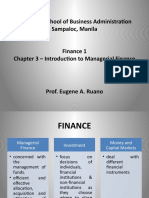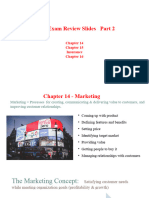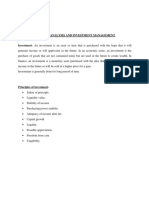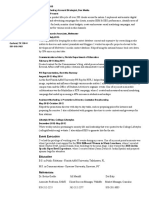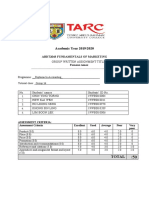STFM Reviewer
STFM Reviewer
Uploaded by
angelesangela32Copyright:
Available Formats
STFM Reviewer
STFM Reviewer
Uploaded by
angelesangela32Original Title
Copyright
Available Formats
Share this document
Did you find this document useful?
Is this content inappropriate?
Copyright:
Available Formats
STFM Reviewer
STFM Reviewer
Uploaded by
angelesangela32Copyright:
Available Formats
SWOT Analysis- process of strategic planning to analyze business SWOT Analysis- process of strategic planning to analyze business SWOT
usiness SWOT Analysis- process of strategic planning to analyze business
competitive advantage in the industry competitive advantage in the industry competitive advantage in the industry
Master Budget- summary of consolidated budget among different Master Budget- summary of consolidated budget among different Master Budget- summary of consolidated budget among different
units Budget Manuals- guide for budget preparation of a company units Budget Manuals- guide for budget preparation of a company units Budget Manuals- guide for budget preparation of a company
Operating Budget- composed of a detailed presentation of revenues, Operating Budget- composed of a detailed presentation of revenues, Operating Budget- composed of a detailed presentation of revenues,
expenses and net profit expenses and net profit expenses and net profit
Executive Opinion Method- method of estimating sales that Executive Opinion Method- method of estimating sales that Executive Opinion Method- method of estimating sales that
considers the idea of the top management considers the idea of the top management considers the idea of the top management
Sales Trend Analysis- method in which estimating sales are done Sales Trend Analysis- method in which estimating sales are done Sales Trend Analysis- method in which estimating sales are done
through an analysis of the performance of a particular product through an analysis of the performance of a particular product through an analysis of the performance of a particular product
during its cycle during its cycle during its cycle
Cash Budget- budget of plan of cash receipts and disbursements Cash Budget- budget of plan of cash receipts and disbursements Cash Budget- budget of plan of cash receipts and disbursements
Budget- yardstick to which the results of the daily operations of the Budget- yardstick to which the results of the daily operations of the Budget- yardstick to which the results of the daily operations of the
company are matched, coordinated, evaluated, and controlled company are matched, coordinated, evaluated, and controlled company are matched, coordinated, evaluated, and controlled
Strategy- long term course solving large-scale business problems Strategy- long term course solving large-scale business problems Strategy- long term course solving large-scale business problems
Tactics- pays more attention to each transaction such as forecasting Tactics- pays more attention to each transaction such as forecasting Tactics- pays more attention to each transaction such as forecasting
consequences and assessing risks consequences and assessing risks consequences and assessing risks
Behavioral Finance- study of various physiological factor's that will Behavioral Finance- study of various physiological factor's that will Behavioral Finance- study of various physiological factor's that will
affect the financial market. affect the financial market. affect the financial market.
Mental Accounting- profencity of people to allocate their financial Mental Accounting- profencity of people to allocate their financial Mental Accounting- profencity of people to allocate their financial
resources base on more specific needs. resources base on more specific needs. resources base on more specific needs.
Herd Behavior- follows the move of investors or behavior in the Herd Behavior- follows the move of investors or behavior in the Herd Behavior- follows the move of investors or behavior in the
market. Tend to mimic their behavior in the stock market. market. Tend to mimic their behavior in the stock market. market. Tend to mimic their behavior in the stock market.
Emotional Gap- investment decision making lies in the emotion. Emotional Gap- investment decision making lies in the emotion. Emotional Gap- investment decision making lies in the emotion.
Anchoring- attaching their spending level to base on their certain Anchoring- attaching their spending level to base on their certain Anchoring- attaching their spending level to base on their certain
reference. reference. reference.
Self-attribution- over confident on a particular investment Self-attribution- over confident on a particular investment Self-attribution- over confident on a particular investment
Confirmation Bias- If the investor has already had her belief on the Confirmation Bias- If the investor has already had her belief on the Confirmation Bias- If the investor has already had her belief on the
investment she will still invest on it despite what others will say. investment she will still invest on it despite what others will say. investment she will still invest on it despite what others will say.
Experiential Bias- have actual experienced, and believes that it will Experiential Bias- have actual experienced, and believes that it will Experiential Bias- have actual experienced, and believes that it will
occur again. occur again. occur again.
Loss aversion- more concern in the losses rather than market gains. Loss aversion- more concern in the losses rather than market gains. Loss aversion- more concern in the losses rather than market gains.
Familiarity bias- investors tend to invest in what they know. Familiarity bias- investors tend to invest in what they know. Familiarity bias- investors tend to invest in what they know.
Market crashes- can be bull price (pataas) or bear market price Market crashes- can be bull price (pataas) or bear market price Market crashes- can be bull price (pataas) or bear market price
(pababa) (pababa) (pababa)
Stocks - price (down) = buy; (up) price = sell Stocks - price (down) = buy; (up) price = sell Stocks - price (down) = buy; (up) price = sell
Efficient market hypothesis- all informations are available and open Efficient market hypothesis- all informations are available and open Efficient market hypothesis- all informations are available and open
to investors (less tax) to investors (less tax) to investors (less tax)
Insider Trading- illegal use of information that is not yet made public Insider Trading- illegal use of information that is not yet made public Insider Trading- illegal use of information that is not yet made public
Petty Cash Fund- cater the small expenditures of the company. Petty Cash Fund- cater the small expenditures of the company. Petty Cash Fund- cater the small expenditures of the company.
Change Fund- maintain loose change to address the concern for Change Fund- maintain loose change to address the concern for Change Fund- maintain loose change to address the concern for
small bills and coins small bills and coins small bills and coins
Dividend Fund- used to pay for the dividend which the board of Dividend Fund- used to pay for the dividend which the board of Dividend Fund- used to pay for the dividend which the board of
directors have declared and payable a time certain in the future. directors have declared and payable a time certain in the future. directors have declared and payable a time certain in the future.
Sinking fund- money set aside/saved to pay off a debt/bond. Sinking fund- money set aside/saved to pay off a debt/bond. Sinking fund- money set aside/saved to pay off a debt/bond.
Preference redemption fund- returning the preference share capital Preference redemption fund- returning the preference share capital Preference redemption fund- returning the preference share capital
to the preference shareholders to the preference shareholders to the preference shareholders
Contingent fund- to meet some urgent or unforeseen expenditure of Contingent fund- to meet some urgent or unforeseen expenditure of Contingent fund- to meet some urgent or unforeseen expenditure of
the organization the organization the organization
TRUE 1. The interest of a time deposit placement with the bank can TRUE 1. The interest of a time deposit placement with the bank can TRUE 1. The interest of a time deposit placement with the bank can
be received at maturity date. be received at maturity date. be received at maturity date.
TRUE 2. Good internal control dictates that no one should have a TRUE 2. Good internal control dictates that no one should have a TRUE 2. Good internal control dictates that no one should have a
monopoly of the transactions related to cash. monopoly of the transactions related to cash. monopoly of the transactions related to cash.
FALSE 3. It is a good practice for collectors to issue an official receipt FALSE 3. It is a good practice for collectors to issue an official receipt FALSE 3. It is a good practice for collectors to issue an official receipt
to the customer who pays his/her account. to the customer who pays his/her account. to the customer who pays his/her account.
TRUE 4. Company policies related to cash are guidelines by which TRUE 4. Company policies related to cash are guidelines by which TRUE 4. Company policies related to cash are guidelines by which
the staff should be guided and protected. the staff should be guided and protected. the staff should be guided and protected.
TRUE 5. Deposits in banks with financial difficulty should be TRUE 5. Deposits in banks with financial difficulty should be TRUE 5. Deposits in banks with financial difficulty should be
presented in the balance sheet at net realizable value. presented in the balance sheet at net realizable value. presented in the balance sheet at net realizable value.
TRUE 6. Short-term investments acquired maturing within three TRUE 6. Short-term investments acquired maturing within three TRUE 6. Short-term investments acquired maturing within three
months are considered as cash equivalent. months are considered as cash equivalent. months are considered as cash equivalent.
TRUE 7. Inherent risks are those risks that are already built-in in the TRUE 7. Inherent risks are those risks that are already built-in in the TRUE 7. Inherent risks are those risks that are already built-in in the
organization and therefore cannot be eliminated but minimized. organization and therefore cannot be eliminated but minimized. organization and therefore cannot be eliminated but minimized.
TRUE 8. Foreign currency deposit with the bank should be translated TRUE 8. Foreign currency deposit with the bank should be translated TRUE 8. Foreign currency deposit with the bank should be translated
into current exchange rate at the end of accounting period. into current exchange rate at the end of accounting period. into current exchange rate at the end of accounting period.
TRUE 9. Provisional receipts are used when the customer pays the TRUE 9. Provisional receipts are used when the customer pays the TRUE 9. Provisional receipts are used when the customer pays the
company a check that will be subject to a 3-day clearing period. company a check that will be subject to a 3-day clearing period. company a check that will be subject to a 3-day clearing period.
TRUE 10. Depositing the cash collection daily will minimize the risk of TRUE 10. Depositing the cash collection daily will minimize the risk of TRUE 10. Depositing the cash collection daily will minimize the risk of
misusing the cash. misusing the cash. misusing the cash.
FALSE 1) Financial Accounting is the process of planning, directing, FALSE 1) Financial Accounting is the process of planning, directing, FALSE 1) Financial Accounting is the process of planning, directing,
organizing, controlling and monitoring the monetary resources organizing, controlling and monitoring the monetary resources organizing, controlling and monitoring the monetary resources
FALSE 2) The ultimate goal of the corporation is maximizing its FALSE 2) The ultimate goal of the corporation is maximizing its FALSE 2) The ultimate goal of the corporation is maximizing its
market value, same as shareholder’s wealth maximization. market value, same as shareholder’s wealth maximization. market value, same as shareholder’s wealth maximization.
FALSE 3) Profit maximization does not consider the discount rate FALSE 3) Profit maximization does not consider the discount rate FALSE 3) Profit maximization does not consider the discount rate
which reflects the risks of capitalization and the time value of money which reflects the risks of capitalization and the time value of money which reflects the risks of capitalization and the time value of money
TRUE 4) Profit maximization and cost minimization are goals of any TRUE 4) Profit maximization and cost minimization are goals of any TRUE 4) Profit maximization and cost minimization are goals of any
business organization. business organization. business organization.
FALSE 5) Shareholder’s wealth maximization may be obtained FALSE 5) Shareholder’s wealth maximization may be obtained FALSE 5) Shareholder’s wealth maximization may be obtained
through increase in amounts of dividends declared through increase in amounts of dividends declared through increase in amounts of dividends declared
TRUE 6) The roles of financial managers are to decide on its TRUE 6) The roles of financial managers are to decide on its TRUE 6) The roles of financial managers are to decide on its
investing, financing and operating activities. investing, financing and operating activities. investing, financing and operating activities.
FALSE 7) The treasurer’s responsibility mainly focuses on the FALSE 7) The treasurer’s responsibility mainly focuses on the FALSE 7) The treasurer’s responsibility mainly focuses on the
accounting and budgeting processes. accounting and budgeting processes. accounting and budgeting processes.
FALSE 8) The controller’s responsibility is to raise adequate funds FALSE 8) The controller’s responsibility is to raise adequate funds FALSE 8) The controller’s responsibility is to raise adequate funds
and maintain control of such funds for the company. and maintain control of such funds for the company. and maintain control of such funds for the company.
FALSE 9) The CFO is also known as the Vice President of Finance FALSE 9) The CFO is also known as the Vice President of Finance FALSE 9) The CFO is also known as the Vice President of Finance
Department who supervises the treasurer not the controller. Department who supervises the treasurer not the controller. Department who supervises the treasurer not the controller.
FALSE 10) The Chief Financial Officer is also known as the Vice FALSE 10) The Chief Financial Officer is also known as the Vice FALSE 10) The Chief Financial Officer is also known as the Vice
President of Finance department who supervises the treasurer not President of Finance department who supervises the treasurer not President of Finance department who supervises the treasurer not
the controller. the controller. the controller.
TRUE 11) The board of directors is considered owners who are TRUE 11) The board of directors is considered owners who are TRUE 11) The board of directors is considered owners who are
responsible for the overall governance of the corporation. responsible for the overall governance of the corporation. responsible for the overall governance of the corporation.
TRUE 12) The sole proprietorship business is subject to lesser TRUE 12) The sole proprietorship business is subject to lesser TRUE 12) The sole proprietorship business is subject to lesser
regulations as compared to the corporation as a business. regulations as compared to the corporation as a business. regulations as compared to the corporation as a business.
FALSE 13) The amount of capital of the corporation is usually smaller FALSE 13) The amount of capital of the corporation is usually smaller FALSE 13) The amount of capital of the corporation is usually smaller
than that of the partnership as a business. than that of the partnership as a business. than that of the partnership as a business.
TRUE 14) Compensating managers with stock can reduce the agency TRUE 14) Compensating managers with stock can reduce the agency TRUE 14) Compensating managers with stock can reduce the agency
problem between stockholders and managers. problem between stockholders and managers. problem between stockholders and managers.
TRUE 15) There is a conflict between stockholders and bondholder TRUE 15) There is a conflict between stockholders and bondholder TRUE 15) There is a conflict between stockholders and bondholder
wherein the former wants the management to take risky wherein the former wants the management to take risky wherein the former wants the management to take risky
investments while the latter wants the less risk investments. investments while the latter wants the less risk investments. investments while the latter wants the less risk investments.
TRUE 16) Good reputation may be attained through ethical business TRUE 16) Good reputation may be attained through ethical business TRUE 16) Good reputation may be attained through ethical business
practices and is considered as the best advertisement. practices and is considered as the best advertisement. practices and is considered as the best advertisement.
TRUE 17) The firm should always consider their corporate social TRUE 17) The firm should always consider their corporate social TRUE 17) The firm should always consider their corporate social
responsibility in doing business. responsibility in doing business. responsibility in doing business.
TRUE 18) If there are conflict between profit maximization and TRUE 18) If there are conflict between profit maximization and TRUE 18) If there are conflict between profit maximization and
ethical consideration, the latter must prevail. ethical consideration, the latter must prevail. ethical consideration, the latter must prevail.
FALSE 19) If there are conflict between shareholder’s wealth FALSE 19) If there are conflict between shareholder’s wealth FALSE 19) If there are conflict between shareholder’s wealth
maximization and ethical consideration, the former must prevail. maximization and ethical consideration, the former must prevail. maximization and ethical consideration, the former must prevail.
TRUE 20) Managers generally welcome hostile takeovers since they TRUE 20) Managers generally welcome hostile takeovers since they TRUE 20) Managers generally welcome hostile takeovers since they
often increase the company’s stock price. often increase the company’s stock price. often increase the company’s stock price.
You might also like
- ACCA F3 Top Words - Vocabulary-1Document11 pagesACCA F3 Top Words - Vocabulary-1oscu0802100% (1)
- Aswath Damodaran On ValuationDocument200 pagesAswath Damodaran On ValuationSanjeev GoswamiNo ratings yet
- 3 Corporate Social Responsibility - The Concept CHP 7 (Jan 22)Document27 pages3 Corporate Social Responsibility - The Concept CHP 7 (Jan 22)fidansekiz100% (1)
- COSO, COBIT, and Manual Internal Control QuestionsDocument9 pagesCOSO, COBIT, and Manual Internal Control QuestionsMarianne SironNo ratings yet
- 040 Module 24 Drive Standard Work Overview v3Document68 pages040 Module 24 Drive Standard Work Overview v3enjoythedocs100% (1)
- International Human Resource Management - AnsDocument6 pagesInternational Human Resource Management - AnsJay KrishnaNo ratings yet
- Lecture 09 Value Chain AnalysisDocument29 pagesLecture 09 Value Chain AnalysisDavid HermanNo ratings yet
- DuettoDocument3 pagesDuettoAnonymous qR62w85eNo ratings yet
- STFM QuizzesDocument2 pagesSTFM Quizzesangelesangela32No ratings yet
- Finman - ReviewerDocument10 pagesFinman - ReviewerGian CPANo ratings yet
- Basic Long Term Financial ConceptsDocument8 pagesBasic Long Term Financial ConceptsJohnpaul FloranzaNo ratings yet
- Financial Management Prelim ReviewerDocument3 pagesFinancial Management Prelim RevieweryenismeeeNo ratings yet
- 1st Prelim Reviewer in FinanceDocument7 pages1st Prelim Reviewer in FinancemarieNo ratings yet
- Business FinanceDocument1 pageBusiness FinanceGracely Calliope De JuanNo ratings yet
- Business FinanceDocument45 pagesBusiness FinanceAndrei Jess Santos CachoNo ratings yet
- The Definition of FinanceDocument9 pagesThe Definition of FinanceJan Mae EstaresNo ratings yet
- BF Week2Document24 pagesBF Week2Clird Ford CastilloNo ratings yet
- Corporate Finance (Key Notes)Document53 pagesCorporate Finance (Key Notes)Pradeepa VNo ratings yet
- Resumen FincorporativasDocument56 pagesResumen FincorporativasJuanaArbuluMuñozNo ratings yet
- BF Q3W1Document5 pagesBF Q3W1Whyljyne Mary GlasanayNo ratings yet
- 3SG210 Zápisky TOP AnetDocument56 pages3SG210 Zápisky TOP Anetkarolinasury9No ratings yet
- 06 Econ 118 ValuationDocument19 pages06 Econ 118 ValuationPaul KimNo ratings yet
- Financial Management Strategies - NotetakingDocument15 pagesFinancial Management Strategies - NotetakinglouellakayleyNo ratings yet
- Financial ManagementDocument24 pagesFinancial ManagementJulius Earl MarquezNo ratings yet
- Surakarta, 2010: Didiek S. Wiyono, ST, MTDocument15 pagesSurakarta, 2010: Didiek S. Wiyono, ST, MTvestereverNo ratings yet
- Chapter 3 Cash Flows and Financial AnalysisDocument6 pagesChapter 3 Cash Flows and Financial AnalysisHannah Pauleen G. LabasaNo ratings yet
- New Venture Is Committed To Turning Ideas Into Action and enDocument2 pagesNew Venture Is Committed To Turning Ideas Into Action and enalvy2099No ratings yet
- Financial Management - Module 1 - 3Document5 pagesFinancial Management - Module 1 - 322-54470No ratings yet
- Midterm Exam Study GuideDocument7 pagesMidterm Exam Study GuideElena RuzoNo ratings yet
- Financial Management - SBSDocument158 pagesFinancial Management - SBSHamsa SrinivasNo ratings yet
- Financial Management - 1 3-Credit Core Course For MBA (IB) 2020-22 Day TimeDocument20 pagesFinancial Management - 1 3-Credit Core Course For MBA (IB) 2020-22 Day TimeHimanshu GuptaNo ratings yet
- Business Finance Concepts Midterm ReviewerDocument15 pagesBusiness Finance Concepts Midterm ReviewerPasccuale FuentesNo ratings yet
- Working Capital ManagementDocument14 pagesWorking Capital Managementmh bachooNo ratings yet
- ACCT-123 Chapter 3Document81 pagesACCT-123 Chapter 3HarshveerNo ratings yet
- S1 IntroDocument20 pagesS1 IntroMayank SinghNo ratings yet
- Active Value Investing NotesDocument17 pagesActive Value Investing Notesanandbajaj0100% (1)
- ABM NotesDocument9 pagesABM Notesdanie.hermosaNo ratings yet
- Processes of Financial ManagementDocument7 pagesProcesses of Financial ManagementHarryNo ratings yet
- Mutual Funds: A Presentation by - Munish Sharma (Ca-Final)Document28 pagesMutual Funds: A Presentation by - Munish Sharma (Ca-Final)SANCHI610No ratings yet
- UntitledDocument6 pagesUntitledLucinta LunaNo ratings yet
- Finanace Easy To RememberDocument12 pagesFinanace Easy To RememberDean TsolakisNo ratings yet
- FinmanDocument3 pagesFinmanDiana Rose BassigNo ratings yet
- Cash Flow Analysis - Fin658Document3 pagesCash Flow Analysis - Fin658ANIS SYAHMINo ratings yet
- Business Enterprise SimulationDocument6 pagesBusiness Enterprise SimulationFrancine CasidaNo ratings yet
- (Notes) Financial Management FundamentalsDocument65 pages(Notes) Financial Management FundamentalsJoanna Danielle AngNo ratings yet
- Introduction To FinanceDocument32 pagesIntroduction To FinancezhengcunzhangNo ratings yet
- FM Notes 3Document1 pageFM Notes 3willjoy alvarezNo ratings yet
- FM ansDocument170 pagesFM ansAlex HoeyNo ratings yet
- Chapter 3 Introduction To Managerial FinanceDocument25 pagesChapter 3 Introduction To Managerial FinanceEunice NunezNo ratings yet
- Simplified SFM Theory Book by CA Jatin Nagpal - CompressedDocument47 pagesSimplified SFM Theory Book by CA Jatin Nagpal - CompressedSatyendraGuptaNo ratings yet
- 72712-29656-Mutual FundsDocument27 pages72712-29656-Mutual FundsAnkush JakkaNo ratings yet
- IFRS Vs US GAAP - 2024Document8 pagesIFRS Vs US GAAP - 2024AMARTYA KUMAR DAS PGP 2023-25 BatchNo ratings yet
- Part 4 (Introduction To Finance)Document7 pagesPart 4 (Introduction To Finance)beadri1526No ratings yet
- Finance BasicsDocument6 pagesFinance BasicsBushra HaqueNo ratings yet
- Final Exam Review Part 2 F20 CH 14 15 16 InsuranceDocument49 pagesFinal Exam Review Part 2 F20 CH 14 15 16 InsuranceHYOUNGGUN KIMNo ratings yet
- Introduction To Alternative InvestmentDocument7 pagesIntroduction To Alternative InvestmentSimran SangwanNo ratings yet
- Accounts Theory-1Document16 pagesAccounts Theory-1jka242000No ratings yet
- Working CapitalDocument62 pagesWorking CapitalHrithika AroraNo ratings yet
- 45MB 0045-Financial ManagementDocument4 pages45MB 0045-Financial ManagementAbdullah AzadNo ratings yet
- Security Analysis and Investment ManagementDocument8 pagesSecurity Analysis and Investment ManagementRevanth NarigiriNo ratings yet
- FINC6021 - Financial StatementsDocument126 pagesFINC6021 - Financial Statements尹米勒No ratings yet
- Zerodha VarsityDocument2 pagesZerodha VarsityPranay GuptaNo ratings yet
- Prof. A. Damodaran - ValuationDocument17 pagesProf. A. Damodaran - ValuationBooks like AlikeNo ratings yet
- Active Value Investing Process by Vitaliy Katsenelson, CFADocument16 pagesActive Value Investing Process by Vitaliy Katsenelson, CFAVitaliyKatsenelsonNo ratings yet
- Management Accounting Assignment Sample - Instant Assignment HelpDocument19 pagesManagement Accounting Assignment Sample - Instant Assignment HelpInstant Assignment HelpNo ratings yet
- Elements of MarketingDocument12 pagesElements of MarketingHannah CokerNo ratings yet
- Final New Tally MaterialDocument108 pagesFinal New Tally Materialsneha100% (1)
- Analisis Sikap, Konsistensi Dan Kepuasan Pada Teh Kotak Ultrajaya: An ExperimentalDocument18 pagesAnalisis Sikap, Konsistensi Dan Kepuasan Pada Teh Kotak Ultrajaya: An ExperimentalRifqi Muhammad HanifNo ratings yet
- Multilocational RetailingDocument33 pagesMultilocational RetailingAkshay ShahNo ratings yet
- Intermediate Accounting I - InventoriesDocument2 pagesIntermediate Accounting I - InventoriesJoovs JoovhoNo ratings yet
- The Challenge of Digital Transformation: Karim R. Lakhani - Harvard Business SchoolDocument19 pagesThe Challenge of Digital Transformation: Karim R. Lakhani - Harvard Business SchoolAmitabh AnandNo ratings yet
- Mirasha Brown's New ResumeDocument1 pageMirasha Brown's New ResumemirashabrownNo ratings yet
- Diplahan National High SchoolDocument3 pagesDiplahan National High SchoolAllen Rey YeclaNo ratings yet
- Ford JIT CaseDocument7 pagesFord JIT CaseMamta Bansal0% (1)
- InventoriesDocument6 pagesInventoriesElla Mae VergaraNo ratings yet
- Privatization of PTCL: Poor Corporate GovernanceDocument7 pagesPrivatization of PTCL: Poor Corporate GovernanceNiaz Yousafzai100% (1)
- Archer Daniels Midland and The Friendly CompetitorsDocument18 pagesArcher Daniels Midland and The Friendly CompetitorsMaria Fransiska Santoso0% (1)
- Academic Year 2019/2020: Abdt2043 Fundamentals of Marketing Famous AmosDocument27 pagesAcademic Year 2019/2020: Abdt2043 Fundamentals of Marketing Famous AmoslimNo ratings yet
- Form # PME - Site Visit - MMMDocument3 pagesForm # PME - Site Visit - MMMacomicbookguy100% (2)
- Proof - Funds-Assinado PT En-EnDocument6 pagesProof - Funds-Assinado PT En-Enopluxe8No ratings yet
- RRL 2019-2023Document13 pagesRRL 2019-2023Raie Mie Ladisla100% (1)
- Information System Strategic Planning in Is / It Service ProviderDocument10 pagesInformation System Strategic Planning in Is / It Service ProviderNicht BoolNo ratings yet
- Samsung Corp V Devon Industries SDN BHD (1995) 3 SLR (R) 603 (1995) SGHC 246Document10 pagesSamsung Corp V Devon Industries SDN BHD (1995) 3 SLR (R) 603 (1995) SGHC 246SiddharthNo ratings yet
- Dangote Integrated Manual RefineryDocument54 pagesDangote Integrated Manual RefineryJustin B NickafNo ratings yet
- Revised - Why MBA - Institute - PPT DEC 5 - 2019Document29 pagesRevised - Why MBA - Institute - PPT DEC 5 - 2019guptap20No ratings yet
- Sarah's Blackbook Reseach 01Document75 pagesSarah's Blackbook Reseach 01taiteelNo ratings yet
- Independent Directors of A CompanyDocument16 pagesIndependent Directors of A CompanySaumya SrividyaNo ratings yet
- Consumer Behaviour Towards NikeDocument11 pagesConsumer Behaviour Towards Nikemaryamalhail6No ratings yet





















